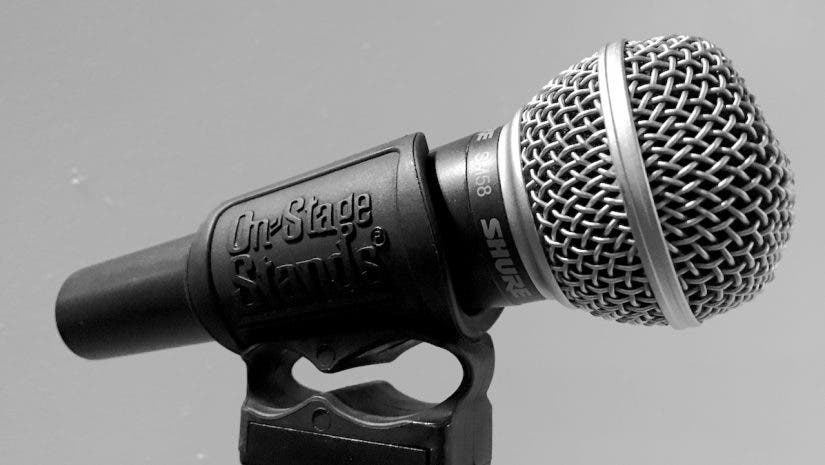By far the most popular vocal microphone of all time, the Shure SM58 Microphone has stood the test of time as the most recognizable and best-selling vocal microphone of all time. The “SM” is an abbreviation for “studio microphone.” This is a nod to its intended market of television and radio broadcasters. Despite its intended usage, the SM58 found its home in theatres, stages, and arenas all over the world.
It wouldn’t be a stretch to say that every modern musician of the past 40+ years has met the model at some point in their career. So, what exactly is all the fuss about? The SM58 boasts an excellent convergence of sound quality, durability, and accessibility, and price point.
The Sound of the SM58
The sound of the microphone is so widespread, it has become a characteristic in its own right. It is a dynamic microphone with a cardioid pickup pattern. This means the SM58 benefits from proximity effect, an electroacoustic accentuation of low-end frequencies when close-mic’ing a source (like a vocal). Its signature presence peak from 2kHz to 6kHz is particularly useful for enhancing vocal intelligibility. It has excellent off-axis noise rejection and an almost complete rejection from the rear of the microphone to assist with eliminating feedback. This is another reason it’s so ubiquitous in live sound.
The microphone is most sensitive at its address end. It features excellent off-axis rejection of unwanted signals, and picks frequencies with the greatest accuracy between 50Hz to 15,000Hz. Vocal energy is generally confined to exactly this frequency range, which is certainly an intentional part of the design.
Durability
This particular microphone model is also known for its legendary durability. It’s housed in an all-metal chassis. There are plenty of case studies of these microphones being run over by trucks, doused in water, and used as a hammer without affecting operation. One of my first impressions of the SM58 was from an article written in 2008, in which an engineer buried the microphone in their backyard, dug it up a year later, and plugged it in without issue.
Much of its stoutness is thanks to the fact that it has only one moving part — a coil of fine copper wire adhered to a mylar plastic diaphragm. Fewer moving parts means fewer things to break. That’s why these seemingly last forever. All of this is to say, the SM58 microphone is reliable. In the world of live sound reinforcement, where system components can be exposed to the elements, confidence in microphone durability is a must.
Accessibility
As the microphone has gained more notoriety throughout the years, it’s actually become cheaper and easier to purchase. It’s original price point of $81 (in 1966) equates to around $700 in 2022. Due to its popularity and long-term appeal, it’s been able to be manufactured en masse without compromise on build quality. Naturally, this is why these microphones can be found in just about every theatre, venue, and house of worship across the globe.
Design
The SM58 also boasts several subtle design features that go often unseen – but not unheard. An internal pneumatic shock mount all but eliminates handling noise. This is a necessary feature considering how often vocalists use the mic as a handheld. Its metal grille — in addition to softening vocal plosives — is designed to dent when dropped, much like a crumple-zone on a car body.
This helps protect the inner workings of the microphone in the event of the drop. The dented grille can either be repaired by pushing out from the inside, or replaced altogether. Lastly, design features render the lightweight microphone diaphragm incapable of breaking due to loud sounds. The excursion is capped by a metal plate, preventing it from coming completely unseated.
It is both true and well-known that the SM58 shares the same microphone capsule as the SM57. The two are virtually the same microphone – the distinguishing differences being the grille. The SM57 — intended for instruments —has a rotating plastic grille secured by a spring metal clip. The SM58 — intended for vocals — has a metal ball grille that threads to a closing ring.
The geometry of each grille slightly alters the high frequency response. It gives each model a slightly different sound, but one would be correct to say their sounds are roughly equivalent. That said, the ball-style grille of the SM58 helps minimize vocal plosives. So, I would also recommend an SM58 for instrumental applications in a pinch.
Final Thoughts
The SM58 works best when being used for live sound, though it can find its way into recording studios and records as well. Being a dynamic microphone, it does also require extra gain at the pre-amp to bring the resultant signal to level.
Ultimately, my opinion toward the SM58 is that of the utmost respect. As a sound engineer, it’s one of your most basic and reliable tools. Any time I spec a package of microphones for a show, I always throw in extra SM58’s and SM57’s – just in case something doesn’t work, or the onsite needs expand at the last minute. Just like a musician knows their scales, so too must a sound engineer know the SM58 like the back of their hand. It will undoubtedly be presented to you time and time again.
If I were stranded on a desert island and I had a single choice of microphone to keep with me, I can’t think of a better choice than the SM58. It will certainly handle the humidity!
Looking to learn more? Check out How to Choose a Shotgun Microphone.






